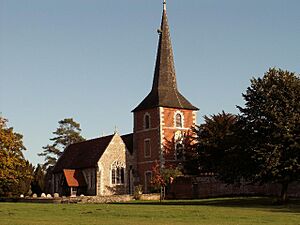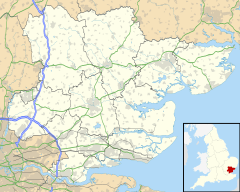Terling facts for kids
Quick facts for kids Terling |
|
|---|---|
 All Saints' Church, Terling |
|
| Population | 741 (1991) 764 (2011) |
| OS grid reference | TL767150 |
| District |
|
| Shire county | |
| Region | |
| Country | England |
| Sovereign state | United Kingdom |
| Post town | Chelmsford |
| Postcode district | CM3 |
| Police | Essex |
| Fire | Essex |
| Ambulance | East of England |
| EU Parliament | East of England |
| UK Parliament |
|
Terling (say it like 'Ter-ling') is a small village in Essex, England. It's located between the towns of Braintree, Chelmsford, and Witham. It's also a civil parish, which is a local area with its own council.
Contents
Discover Terling's Past
Terling has a long history, going all the way back to Roman times. An old Saxon document from 627 AD mentions that about 700 acres of land in the Terling and Fairstead areas were settled. Later, in 886, Terling was part of a larger area called the Witham Hundred.
Terling in the Domesday Book
The village is mentioned in the famous Domesday Book from 1086. It was called Tarlinga back then. At that time, about 125 people lived there. Before the Norman Conquest, three important areas of Terling were given to the Abbot of Ely, a religious leader.
Bishops and Farming
During the 1200s, bishops from Norwich bought more land in the area. By 1238, the village was known as Tarlinges. You can still find the remains of their old palace near All Saints’ Church. Later, King Henry VII even used this palace as a hunting lodge.
In the 1300s, more people were encouraged to become farmers. Some of the names of these early farmers are still remembered today in local place names like Loyes, Scarletts, and Porridge Pot.
Village Life in the 1500s
By the 1500s, the village economy mostly relied on growing crops and raising sheep. Other local jobs included tanning animal hides, weaving cloth, making malt (for brewing), and milling flour. Houses back then were built from timber and clay, and they had thatched roofs.
How Terling Got Its Name
The spelling of Terling has changed over time. In 1718, Tarling(e) was the most common way to write it. The spelling Terling became popular during the 1700s. For example, some maps from the early 1700s still show it as Tarling, while later maps started using Terling.
Important Changes in the 1800s
John Strutt, who was the second Baron Rayleigh, made many improvements in Terling. He built the village school and made the church bigger. In 1868, after a serious outbreak of typhoid fever, he even set up a water supply system for the whole village.
Modern Terling
Since 2002, Terling has hosted the Terling International Trifle Festival every September. It sounds like a delicious event! In 2017, Terling was even named the Essex Village of the Year.
Exploring Terling Village
The village of Terling is divided into two parts by the River Ter. Interestingly, the river's name might have come from the village's name, not the other way around!
West Side of the River
On the west side of the river, you'll find places for sports and fun. There's a cricket pitch, tennis courts, a swimming pool, and a playground for kids.
East Side of the River
On the east side of the river, you'll find the village's only pub, called the Rayleigh Arms (but many locals call it the Monkey!). There's also a tearoom, the village shop and post office, Terling Primary School, and the Anglican Church.
Terling's Population
In 1991, Terling had a population of 741 people. By the 2011 Census, the population had grown slightly to 764.
Famous Buildings in Terling
Terling has some interesting and historic buildings.
Terling Place
The main manor house, called Terling Place, was built between 1772 and 1777. It's a beautiful old building.
Terling Windmill
The Terling Windmill is another notable building. It used to be a windmill but has since been changed into a home. This windmill was even featured in an old film called Oh, Mr Porter!.
All Saints' Church
The Anglican church, dedicated to All Saints, is located on the village green. The main part of the church is very old, from the medieval period. It was restored in the 1800s. The brick tower of the church was built in 1732.


